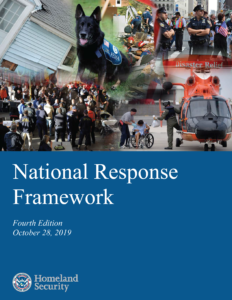Knowledge is Power – Information is Power – Rainmaker is Power
You may never fully understand the complex inner workings of the federal government’s response framework or the interactions between the various support functions. Presidential Policy Directive 8 may not be of interest to you. You may not know or care about the concepts identified in the National Incident Management System (NIMS) or the Five Mission Areas of the National Preparedness Goal.
It is almost certain that your company’s business plan does not leverage the findings of the Strategic National Risk Assessment (SNRA) to determine government agency interactions or the risks and threats identified by the SNRA including natural disasters, pandemic influenza, technological or accidental hazards, terrorist organization or affiliates, or cyber-attacks. You may have heard of the Robert T. Stafford Disaster Relief and Emergency Assistance Act of 1988 (Stafford Act) but did you know that it provides the legal authority for the federal government to assist states during declared major disasters and emergencies?
But do you know how to best position your company’s service, solution, or product to capitalize on the timing of the disaster planning, response, and recovery process and the tens of billions of dollars of contracts to be awarded?
Rainmaker Knows
Rainmaker knows that no single threat or hazard (actual or potential disaster) exists in isolation and that core capabilities must be applied by federal, state, and local governments to deal with cascading events, e.g., a hurricane can lead to flooding, dam failures, and hazardous materials spills. The basis for these capabilities is planning factors drawn from many different scenarios used to develop the Response Federal Interagency Operational Plan (FIOP), which supplements the National Response Framework or NRF.
To be successful in the disaster mitigation and recovery arena, a small business government contractor must understand the concept of federal multi-agency coordination and unified command contained in the command and management component of NIMS. Rainmaker knows the National Response Framework, understands the support functions, and ensures its clients know how, where, and when to find and secure contract opportunities.
Billion-dollar disasters in 2023
In 2023, the U.S. experienced 28 separate billion-dollar disasters. This surpasses 2020 — which had 22 events — for the highest number of billion-dollar disasters in the U.S. on record. The 28 events from 2023 include:
- 17 severe weather/hail events.
- 4 flooding events.
- 2 tropical cyclones (Idalia in Florida and Typhoon Mawar in Guam).
- 2 tornado outbreaks.
- 1 winter storm/cold wave event.
- 1 wildfire event (Maui Island of Hawaii).
- 1 drought and heat wave event.
The total cost for the 28 2023 disasters was $92.9 billion, but that may rise by several billion dollars when the costs of the December 16-18, 2023, East Coast storm and flooding event are fully accounted for
The NRF
 The National Response Framework (NRF) provides a foundational emergency management doctrine for how the Nation responds to all types of incidents. The NRF is built on scalable, flexible, and adaptable concepts identified in the National Incident Management System (NIMS) to align key roles and responsibilities across the Nation.
The National Response Framework (NRF) provides a foundational emergency management doctrine for how the Nation responds to all types of incidents. The NRF is built on scalable, flexible, and adaptable concepts identified in the National Incident Management System (NIMS) to align key roles and responsibilities across the Nation.
The structures, roles, and responsibilities described in this Framework can be partially or fully implemented in the context of a threat or hazard, in anticipation of a significant event, or in response to an incident. Implementation of the structures and procedures described herein allows for a scaled response, delivery of specific resources and capabilities, and a level of coordination appropriate to each incident.
Responding to disasters and emergencies requires the cooperation of various organizations; the larger or more complex the incident, the greater the number and variety of organizations that must respond.
Think of a residential fire: Firefighters are leading the charge; public works may be on the scene providing traffic control; police are providing security; emergency medical services personnel are triaging, transporting, and redistributing injured to local hospitals; and a local nonprofit or voluntary organization (e.g., American Red Cross and Salvation Army) may be on hand to assist displaced residents.
For large disasters, such as major hurricanes or earthquakes, the incident complexity is increased as others—such as states or tribes and, ultimately, the Federal Government—become involved. Businesses, voluntary organizations, and other elements of the private sector are also key stakeholders, providing the essential services that must be restored following an incident.
The NRF provides the foundation for how these organizations coordinate, integrate, and unify their response.
The National Preparedness System outlines an organized process for the whole community to move forward with its preparedness activities and achieve the National Preparedness Goal. The National Response Framework (NRF) sets the strategy and doctrine for how the whole community builds, sustains, and delivers the response core capabilities identified in the National Preparedness Goal in an integrated manner with the other mission areas. The fourth edition of the NRF emphasizes enhancing the unity of effort between the government and the private sector through better coordination and collaboration.
